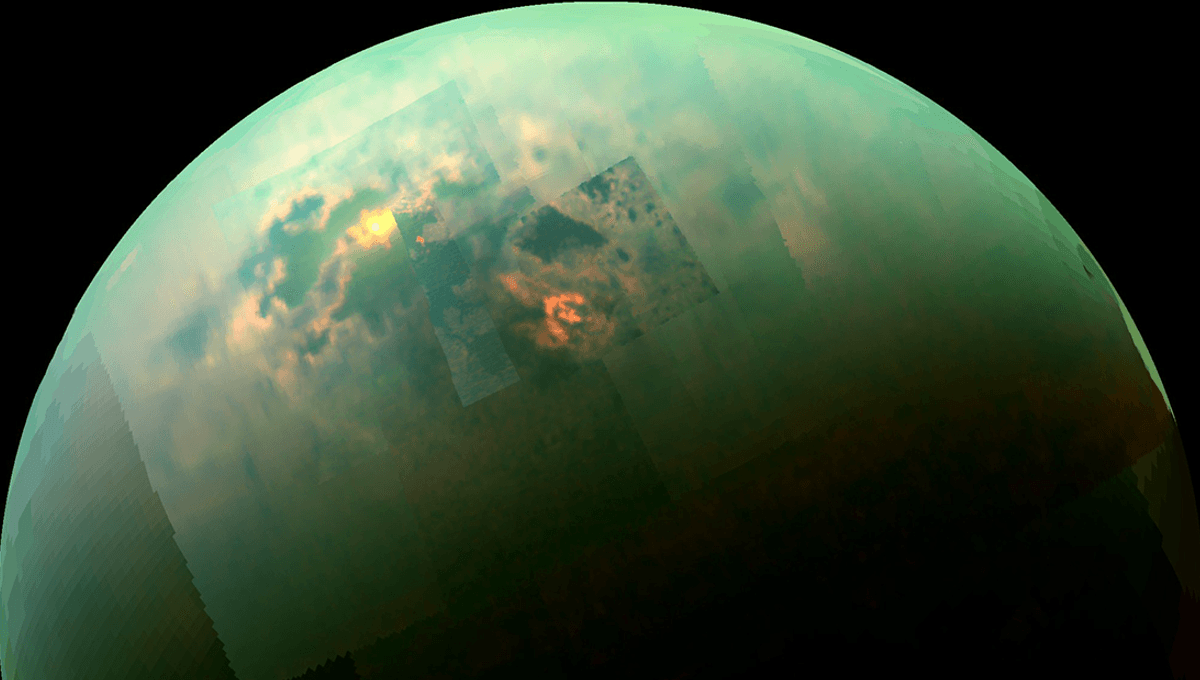
A new study looking at impact cratering on Titan has found bad news in the search for life on the moon, and potentially other icy moons of the Solar System as well.
Titan, Saturn’s largest moon, is often thought of as a potential candidate for life. The moon is the only place in the Solar System – other than Earth – where liquids are known to be present on the surface, making up rivers, lakes and seas.
These water features are made of liquid hydrocarbons, the bulk of which is methane. More intriguing to scientists looking for life is the giant subsurface ocean, thought to be more than 12 times the volume of Earth’s oceans, locked beneath the planet’s icy crust and stretching 55 to 80 kilometers (35 to 50 miles) below the ground.
“Titan’s rivers, lakes and seas of liquid methane and ethane might serve as a habitable environment on the moon’s surface, though any life there would likely be very different from Earth’s life,” NASA explains of the moon. “Titan could potentially harbor environments with conditions suitable for life – meaning both life as we know it (in the subsurface ocean) and life as we don’t know it (in the hydrocarbon liquid on the surface).”
Liquid water under the surface is of course promising for life, but for life to emerge you also need organics. It was thought that these ingredients could be delivered to the ocean below, where they could be swirled around and heated and potentially spark life via the impacts of space objects. The idea was that the surface – rich in organics – would mix with the subsurface ocean as objects impact the surface and melt pools of water in the ice. Being denser than the surrounding ice, this would then sink down to the subsurface ocean.
However, a study from the University of Western Ontario attempted to estimate how many comets impact the moon per year, and the quantity of organics which would be delivered to the subsurface ocean through these impacts. Unfortunately, the team found that the volume of glycine – the simplest amino acid – delivered to the ocean would only be around 7,500 kilograms (16,500 pounds), or around the weight of an adult elephant.
“One elephant per year of glycine into an ocean 12 times the volume of Earth’s oceans is not sufficient to sustain life,” astrobiologist Catherine Neish said in a press release. “In the past, people often assumed that water equals life, but they neglected the fact that life needs other elements, in particular carbon.”
“This work shows that it is very hard to transfer the carbon on Titan’s surface to its subsurface ocean –basically, it’s hard to have both the water and carbon needed for life in the same place,” Neish added.
Given that Titan has more organics on its surface than the other icy moons of Saturn and Jupiter, this puts a bit of a dampener on our search for life within the Solar System.
“Unfortunately, we will now need to be a little less optimistic when searching for extraterrestrial lifeforms within our own Solar System,” Neish said. “The scientific community has been very excited about finding life in the icy worlds of the outer Solar System, and this finding suggests that it may be less likely than we previously assumed.”
Nevertheless, there is still a little wiggle room. Life could be possible, for instance, if there were more organics on the surface than previously estimated, if organics could come from the core, or other processes could deliver organics from the surface to the ocean below.
“It is nearly impossible to determine the composition of Titan’s organic-rich surface by viewing it with a telescope through its organic-rich atmosphere,” Neish added. “We need to land there and sample the surface to determine its composition.”
Fortunately, NASA plans to do just that with the Dragonfly mission, which will see a flying vehicle hop around the moon’s surface. Neish, who is part of the Dragonfly team, says that this research could help identify interesting places to land.
“If all the melt produced by impacts sinks into the ice crust, we wouldn’t have samples near the surface where water and organics have mixed. These are regions where Dragonfly could search for the products of those prebiotic reactions, teaching us about how life may arise on different planets,” said Neish.
“The results from this study are even more pessimistic than I realized with regards to the habitability of Titan’s surface ocean, but it also means that more interesting prebiotic environments exist near Titan’s surface, where we can sample them with the instruments on Dragonfly.”
The study is published in Astrobiology.
Source Link: Solar System's Icy Moons Are Likely Not Hosts To Life, Finds NASA